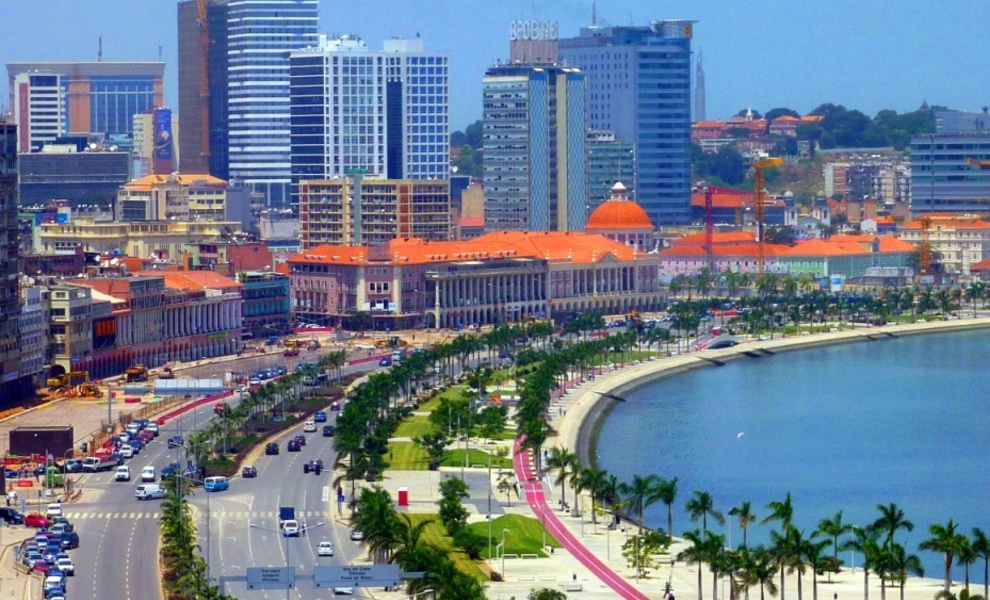
Luanda was ranked the world’s most expensive city for expatriates in Mercer’s 2014 Cost of Living Index, a second straight year it’s beat cities such as Singapore,Hong Kong, Shanghai and Geneva.
Wealthy Feast
While the wealthy can feast on fresh seafood shipped in from the former colonial rulerPortugal at trendy restaurants along the Ilha, a sandy peninsula that juts out from Luanda harbor, most Angolans subsist on funje, a pasty dish made from corn or cassava, a tube root that costs a $1 a kilogram.
Maria Alice caters to that clientele, serving funje with meat, fish, rice and beans. A 25-year-old first-year public administration student at Agostinho Neto University, Alice sells as many as 40 plates of funje a day in Viana and then heads to classes in the evening. The cash helps her pay for food and housing and to buy cosmetics and hair extensions.
“It helps me to pay my bills while I keep my beauty,” she said with a smile.
While the government estimates that the economy may expand 9.7 percent next year, Standard Chartered Plc forecasts a 6 percent increase in gross domestic product in 2015 compared with 4 percent this year.
Corruption Index
There is wealth in Angola; it’s just not distributed well. The number of millionaires in the southern African country will more than double to 15,600 by 2030, a study last year by Johannesburg-based New World Wealth showed. President Jose Eduardo dos Santos’s daughter Isabel is Africa’s richest woman.
Angola ranked 161 out of 174 countries on Transparency International’s 2014 Corruption Perceptions Index.
“Most Angolans are very poor because there’s a lack of wealth distribution, welfare support and investment in education,” Nelson Pestana, a political science professor at the Catholic University of Angola, said by phone from Luanda.
Falling oil prices prompted the southwest African country to scale back investment plans for education, spreading 1 trillion kwanzas in funding over the next decade instead of an originally planned three years.
“Our educational system doesn’t train people for the job market; most of the population is excluded from the national reconstruction process,” Pestana said. “All this contributes to young people entering prostitution, committing crimes and other risky behavior.”
Risking Violence
Over near the central bank headquarters, 17-year-old Ruth Bernardo was walking around in leopard print shorts and high heels at 9 p.m. trying to sell her body to supplement what she makes as a hairdresser in the Mabor slum.
She and the 30 other young women who run toward approaching cars risk violence and infection with HIV, which is prevalent among 23 percent of Angolan sex workers, according to the United Nations Programme on HIV and Aids.
“Sometimes I’m paid and well treated, other times I’m forced to do it for free,” Bernardo said in an interview. “This is the price I have to pay for being poor and powerless.”
Even those with jobs find that the monthly minimum wage of about $200 doesn’t cover everything. The annual inflation rate in Luanda was 7.5 percent last month. For the 25 percent of Angolans that the African Development Bank says are unemployed, reliance on “esquemas,” the Portuguese word for schemes, is vital.
Electricity Sales
One of the more inventive and common ones is to sell electricity from the state power supplier, Empresa de Distribuicao de Electricidade de Luanda EP, to neighbors.
Getting an electricity contract and the correct cables installed costs the equivalent of about $250, plus a monthly fee of about $10, said 18-year-old Sebastiao Adriano. So someone with an agreement with the company can string lines to their neighbors and charge them about $10 a month.
“It isn’t news for anyone in this neighborhood that there are people who re-sell electricity to make a living,” he said in an interview in the Sambizanga neighborhood. “Poverty has enhanced people’s creativity.”
As a result of the jerry-rigged wires that run overhead and snake through mud and concrete block houses, during the October-to-April rainy season people are sometimes electrocuted when their homes are flooded.
Slum Clinics
Even illness provides opportunity in the slums. Rather than stand in lines at state-run hospitals, patients often opt to patronize local clinics that have sprung up.
Daniel Gaspar, 50, a nurse with a high-school education, runs a clinic in Sambizanga when he’s not working at a government hospital, where he makes the equivalent of about $600 a month. Two other nurses help staff the center, which treats 10 to 20 patients a day. The waiting room is a small yard.
“I buy pills, serum, needles and gloves at informal markets,” Gaspar said. “The clinic compensates for my low salary.”
Back in Viana, Baltazar doesn’t seem bitter about his plight as he pushes his makeshift wheelbarrow down the road in search of customers.
“My kids are going to school,” he said. “I’m optimistic tomorrow will be a better day.”
FRENCH VERSION


